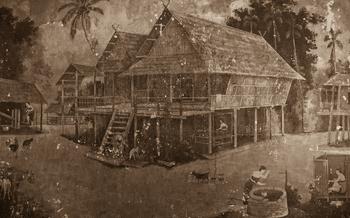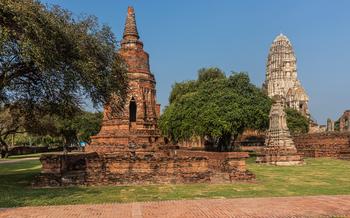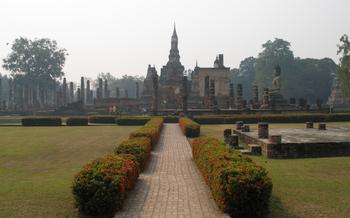
Wat Khao Kaew
- Panoramic Views from the Summit
- Exploring the Temple Grounds
- The Grand Buddha Statue: A Symbol of Faith and Reverence
- The Emerald Buddha Replica
- Exploring the Temple's History
- Local Festivals and Celebrations
- Unique Offerings and Amulets
- Meditation and Spiritual Retreats
- Cultural Exchange and Local Interactions:
- Exploring the Surrounding Area
- Accommodation and Amenities:
- Planning Your Visit to Wat Khao Kaew: Practical Considerations and Tips
- Transportation Options:
- Insider Tip: Unveiling the Hidden Gems of Wat Khao Kaew
Panoramic Views from the Summit
Wat Khao Kaew's elevated position offers breathtaking vistas that extend far beyond the temple grounds, encompassing the picturesque landscape of Nakhon Si Thammarat. Ascending the sacred mountain, visitors are rewarded with a panoramic tapestry of verdant rice fields, shimmering rivers, and distant mountain ranges. The summit provides the perfect vantage point to capture the essence of this enchanting region.
The best time to visit Wat Khao Kaew for optimal views is undoubtedly during the early morning hours, when the air is crisp and clear, and the golden rays of the rising sun illuminate the surroundings, casting a warm glow upon the landscape. As the day progresses, the panorama transforms, revealing new layers of depth and color.
Beyond the stunning vistas, the summit of Wat Khao Kaew is a popular spot for picnics and sunset watching. Visitors can spread out a blanket, savor a leisurely meal, and soak in the tranquil ambiance. As the sun begins its descent, the sky erupts in a kaleidoscope of vibrant hues, creating a breathtaking spectacle that leaves visitors in awe.
For photography enthusiasts, the summit offers endless opportunities to capture stunning images. The panoramic views provide a grand backdrop for landscape shots, while the intricate details of the temple architecture and the surrounding nature offer subjects for close-up photography. With careful composition and a keen eye for detail, visitors can create lasting memories of their visit to this sacred mountain.
Exploring the Temple Grounds
Wat Khao Kaew's expansive grounds offer a treasure trove of sacred sites and serene corners to explore. As you wander through the temple complex, you'll encounter several notable features that hold deep significance for Buddhist devotees.
Gaze upon the majestic Grand Buddha statue, an awe-inspiring representation of the enlightened one, standing tall and radiating peace. Marvel at the intricate details and serene expression of this colossal figure, a testament to the artistry and devotion of its creators.
The temple is also home to numerous Buddha images enshrined within its various chapels and meditation halls. Each Buddha image possesses unique characteristics and represents different aspects of the Buddha's teachings. Take some time to pay your respects and reflect on the profound wisdom and compassion embodied by these sacred figures.
As you explore further, discover hidden corners and tranquil spots perfect for meditation and contemplation. Whether you seek solace amidst the serene surroundings or wish to deepen your spiritual practice, Wat Khao Kaew provides an ideal setting for inner reflection and connection with the divine.
Remember to be mindful of temple etiquette and dress appropriately when visiting the sacred grounds. Remove your shoes before entering any temple building, and wear modest clothing that covers your shoulders and knees. By observing these guidelines, you demonstrate respect for the local customs and help preserve the sanctity of this sacred space.
The Grand Buddha Statue: A Symbol of Faith and Reverence
At the heart of Wat Khao Kaew's sacred grounds stands a majestic Grand Buddha statue, an awe-inspiring embodiment of serenity and spiritual devotion. Soaring high above the temple complex, this colossal statue exudes an aura of tranquility that draws pilgrims and visitors alike. Its intricate details and lifelike features showcase the exceptional craftsmanship and artistic prowess of Thai artisans.
The Grand Buddha statue has a rich and captivating history, deeply intertwined with local beliefs and legends. According to folklore, the statue was constructed during the reign of King Rama V in the late 19th century. It is believed that the king, known for his deep devotion to Buddhism, commissioned the statue to bring blessings and prosperity to the region.
For Buddhist pilgrims, the Grand Buddha statue holds immense spiritual significance. It is a focal point for meditation and prayer, where devotees come to pay homage and seek guidance. The statue is adorned with offerings of flowers, incense, and candles, creating a vibrant and fragrant atmosphere within the temple grounds.
To fully appreciate the grandeur of the Grand Buddha statue, visitors are encouraged to approach it respectfully and observe its intricate details up close. The statue's serene countenance, graceful posture, and meticulously carved robes evoke a sense of awe and inspiration. Visitors can take a moment to sit in contemplation before the statue, absorbing its peaceful energy and connecting with their inner spirituality.
The Emerald Buddha Replica
At Wat Khao Kaew, visitors can marvel at a replica of the revered Emerald Buddha, a highly sacred image in Thailand. The original Emerald Buddha, enshrined in Bangkok's Grand Palace, is believed to date back to the 15th century and is deeply revered by Thai Buddhists. The replica at Wat Khao Kaew, though smaller in size, is crafted with exquisite detail and artistry, capturing the essence of the original. It serves as a testament to the temple's significance as a center of Buddhist devotion and its connection to Thai cultural heritage.
The replica of the Emerald Buddha at Wat Khao Kaew is not merely a decorative piece but holds deep religious significance. It is believed to be imbued with the same sacred power and blessings as the original, attracting countless pilgrims and worshippers seeking spiritual guidance and protection. Devotees often offer prayers, light candles, and make merit in front of the replica, seeking blessings for their well-being and good fortune.
Religious ceremonies and rituals are held throughout the year at Wat Khao Kaew, often centered around the Emerald Buddha replica. These ceremonies involve chanting, meditation, and offerings made by monks and devotees. Visitors are welcome to observe these rituals respectfully, gaining a deeper understanding of Thai Buddhist traditions and the cultural significance of the Emerald Buddha.
Exploring the Temple's History
Wat Khao Kaew's rich history is intertwined with the royal family of Nakhon Si Thammarat and the deep-rooted Buddhist traditions of the region. Founded in the early 19th century under the patronage of King Rama IV, the temple quickly gained prominence as a center of Buddhist learning and pilgrimage. Throughout its history, the temple has undergone several renovations and expansions, each contributing to its architectural grandeur and spiritual significance.
In the early 20th century, King Rama V visited Wat Khao Kaew and initiated the construction of the Grand Buddha statue, which remains one of the temple's most iconic landmarks. The temple's reputation as a sacred site continued to grow, attracting Buddhist pilgrims and devotees from across the region. Over the years, the temple has played a vital role in preserving and promoting Thai Buddhist culture, hosting numerous religious festivals and ceremonies that showcase the vibrant traditions of the local community.
Today, Wat Khao Kaew stands as a living testament to the enduring legacy of Thai Buddhism, embodying the harmonious blend of history, architecture, and spirituality that defines this sacred mountain temple.
Local Festivals and Celebrations
Wat Khao Kaew comes alive during its vibrant festivals and celebrations, which draw devotees and visitors from across the region. The most significant event is the annual temple fair, held during the Songkran festival in April. This lively celebration features colorful processions, traditional Thai dances, and a variety of food stalls and market vendors.
Another notable festival is Visakha Bucha, which commemorates the birth, enlightenment, and passing of Lord Buddha. During this time, the temple is adorned with lanterns and flowers, and special ceremonies and chanting sessions are held throughout the day.
Loy Krathong and Yi Peng, the festivals of light, are also celebrated with great enthusiasm at Wat Khao Kaew. Visitors can release floating kratongs (decorated rafts) into the temple pond and launch sky lanterns, creating a magical atmosphere under the starry sky.
To fully immerse yourself in the local culture, plan your visit to coincide with one of these festivals. It's a fantastic opportunity to witness the temple's vibrant energy, engage with the friendly locals, and experience the rich traditions of Thai Buddhism firsthand.
Unique Offerings and Amulets
Wat Khao Kaew is renowned for its collection of amulets and blessed objects, believed to possess protective powers and bring good fortune to their owners. These amulets, often intricately designed and made from various materials like metals, gems, and sacred powders, are highly sought after by devotees and visitors alike.
The temple's monks perform special ceremonies and blessings to consecrate these amulets, imbuing them with spiritual energy. The process of obtaining an amulet involves making a donation to the temple and requesting a monk to bless and consecrate it.
Visitors can choose from a wide range of amulets, each with its unique properties and significance. Some popular types include protective talismans, wealth-attracting charms, and health-enhancing amulets.
It's important to note that amulets are not merely decorative items; they carry spiritual significance and should be treated with respect. According to Buddhist principles, the effectiveness of an amulet depends on the wearer's faith and virtuous actions.
Visitors are advised to approach the amulet-obtaining process with sincerity and respect, avoiding commercialization or treating it as a mere tourist souvenir. By embracing the spiritual significance of these objects, visitors can enhance their experience at Wat Khao Kaew and take home a meaningful memento of their visit.
Meditation and Spiritual Retreats
Wat Khao Kaew's serene environment provides an ideal setting for meditation and spiritual retreats. Visitors seeking inner peace and self-reflection can find solace within the temple's tranquil grounds. Guided meditation sessions, led by experienced monks, are available for those wishing to deepen their practice. These sessions offer a structured approach to meditation, helping participants to quiet their minds, focus their thoughts, and cultivate mindfulness.
For those seeking a more immersive experience, Wat Khao Kaew offers longer spiritual retreats. These retreats typically last for several days or weeks and provide a comprehensive introduction to Buddhist teachings and practices. Participants engage in daily meditation sessions, chanting, and Dharma talks, delving into the core principles of Buddhism. The temple's tranquil surroundings and supportive community foster a conducive environment for personal growth and spiritual transformation.
Creating a meaningful and transformative retreat at Wat Khao Kaew requires careful planning and preparation. Visitors are advised to set clear intentions for their retreat, whether it's stress reduction, self-discovery, or spiritual awakening. Prior research on Buddhist teachings and meditation techniques can enhance the retreat experience. It's essential to approach the retreat with an open mind and a willingness to embrace new experiences.
To ensure a smooth and fulfilling retreat, visitors should follow the temple's guidelines and respect local customs. This includes adhering to the dress code, maintaining silence in designated areas, and showing reverence towards the Buddha images and monks. By immersing themselves in the temple's serene atmosphere and engaging wholeheartedly in the retreat activities, visitors can embark on a transformative journey that leaves a lasting impact on their lives.
Cultural Exchange and Local Interactions:
Wat Khao Kaew is not just a place of worship but also a vibrant hub for cultural exchange and local interactions. Engaging with the friendly monks and local devotees offers a unique opportunity to learn about Thai Buddhist customs and practices firsthand. Visitors can strike up conversations, ask questions, and gain insights into the daily life and beliefs of the local community. Participating in merit-making activities, such as offering food and flowers to the monks, is a meaningful way to contribute to the temple's upkeep while also experiencing the essence of Thai generosity. Respectful and meaningful interactions with the local community create a bridge between cultures, fostering understanding and appreciation.
Exploring the Surrounding Area
Beyond the temple's sacred grounds, Nakhon Si Thammarat offers a wealth of natural and cultural attractions waiting to be explored. Immerse yourself in the breathtaking beauty of Khao Luang National Park, home to lush rainforests, cascading waterfalls, and diverse wildlife. Hike through the park's scenic trails, encounter fascinating flora and fauna, and discover hidden gems like the stunning Huai Yang Waterfall.
History buffs will delight in exploring the ancient city of Nakhon Si Thammarat, where remnants of its rich past can still be found. Visit the majestic Wat Phra Mahathat, one of Thailand's most important and sacred temples, and admire its impressive architecture and ancient Buddha images. Delve into the intriguing history of the city at the Nakhon Si Thammarat National Museum, which houses a collection of artifacts and exhibits that showcase the region's cultural heritage.
Indulge your taste buds with the region's delectable cuisine at the vibrant local markets. Sample the freshest seafood, savor mouthwatering local delicacies, and immerse yourself in the lively atmosphere of these bustling marketplaces. Don't miss the opportunity to dine at local restaurants, where you can savor authentic Thai dishes prepared with local ingredients and traditional recipes.
To make the most of your visit, consider creating a comprehensive itinerary that allows you to explore both Wat Khao Kaew and the surrounding area. Allocate ample time to fully immerse yourself in the temple's spiritual and cultural significance while leaving room to discover the region's natural wonders and historical treasures.
Accommodation and Amenities:
For a comfortable stay near Wat Khao Kaew, there are several accommodation options to choose from. Budget-conscious travelers can opt for guesthouses or hostels, offering basic yet clean rooms. For a more luxurious experience, there are a few resorts and hotels in the vicinity that provide modern amenities and stunning views of the surrounding landscape.
Within the temple grounds, visitors will find basic facilities such as restrooms and drinking water dispensers. However, it's important to note that Wat Khao Kaew is primarily a place of worship, so visitors should be mindful of noise levels and respect the temple's serenity.
When selecting accommodations, consider your budget and preferences. If you prefer to be close to the temple, there are several guesthouses and hotels within walking distance. For those who value privacy and tranquility, there are resorts located a short drive away, offering a more secluded experience amidst nature.
Remember to pack comfortable shoes for exploring the temple's grounds and appropriate attire that respects local customs. While there are no strict dress codes, it's considered respectful to cover your shoulders and knees when visiting religious sites in Thailand.
Planning Your Visit to Wat Khao Kaew: Practical Considerations and Tips
Timing your visit to Wat Khao Kaew is crucial for a pleasant and fulfilling experience. The best time to visit is during the cooler months, from November to February, when the weather is at its most pleasant. Avoid the midday sun by visiting early in the morning or late in the afternoon, especially if you plan to climb the stairs to the summit.
Pack appropriately for your temple visit, considering both comfort and respect. Light, breathable clothing that covers your shoulders and knees is recommended. Remember to remove your shoes before entering the temple and keep your voice low to maintain a tranquil atmosphere.
To avoid crowds and ensure a peaceful experience, try to visit outside of peak tourist hours, which typically fall between 10am and 2pm. If possible, plan your visit on a weekday rather than a weekend or during a Thai public holiday.
Follow these guidelines and practical tips to make the most of your visit to Wat Khao Kaew:
- Dress appropriately: Wear modest clothing that covers your shoulders and knees.
- Remove your shoes: Take off your shoes before entering the temple grounds.
- Be respectful: Speak softly and avoid causing any disturbances.
- Observe local customs: Follow the lead of other visitors and monks.
- Seek guidance: If you have any questions, don't hesitate to ask a monk or temple staff member.
Transportation Options:
Getting to Wat Khao Kaew is relatively easy, with several transportation options available. For those without their own vehicle, public transportation is a convenient and affordable choice. There are regular bus routes from Nakhon Si Thammarat city to the temple, and the journey takes approximately 30 minutes. Alternatively, taxis and tuk-tuks are readily available for hire from the city center and can be negotiated for a reasonable fare.
For those who prefer the freedom and flexibility of self-guided exploration, renting a car or motorbike is an excellent option. Several rental agencies in Nakhon Si Thammarat offer a wide range of vehicles to choose from, and the roads leading to the temple are generally well-maintained. However, it's important to exercise caution when driving in Thailand, as traffic regulations can be different from what you may be accustomed to. Always wear a helmet when riding a motorbike, and be mindful of other road users, especially during peak hours.
Insider Tip: Unveiling the Hidden Gems of Wat Khao Kaew
Beyond the main attractions, Wat Khao Kaew holds several hidden gems that offer unique experiences for visitors. Explore the lesser-known corners of the temple complex to discover secluded spots with breathtaking views, serene meditation areas nestled amidst lush gardens, and ancient Buddha statues shrouded in mystery.
For a culinary adventure, venture off the beaten path to find local restaurants frequented by the temple's devotees. These hidden culinary havens serve authentic Thai dishes prepared with fresh local ingredients, offering a taste of the region's rich gastronomic traditions.
Photography enthusiasts should seek out secret viewpoints within the temple grounds that provide unparalleled panoramic vistas. Capture stunning shots of the surrounding landscape, with the temple's golden stupas and lush greenery creating a picturesque backdrop.
Finally, inquire about special events or ceremonies that may not be widely advertised. These intimate gatherings offer a glimpse into the vibrant religious life of Wat Khao Kaew and provide an opportunity to witness unique rituals and traditions.



